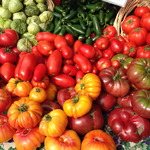The Fat Of The Land-Ripe
Guest User
At one time or another, we’ve all had the splendid experience of biting into ripe fruit—juices oozing, sweetness and aroma filling our senses, exclamations of exaltation. But to find oneself with such a fruit in hand seems, especially in the grocery aisle, like a bit of a crapshoot. For every tart, firm, or lackluster specimen, there are too few superlative ones. Shopping at the farmers’ market or growing your own helps you avoid varieties bred and cultivated for ease of shipping rather than eater satisfaction, but doesn’t guarantee countertops covered in a gallery of perfect fruits. Understanding the nuances of ripeness, and what to expect from different kinds of fruit, can help shoppers and gardeners alike become savvy gatherers.
Our ripeness training is mostly based on color: tomatoes are red, peaches are glowing orange with a blush of red, berries gleam in glossy jewel-tones. While there is some truth to this bias, it is hardly the whole story. Ripeness indicators extend beyond pigmentation, as anyone who’s grown a melon can tell you. Fruits like kiwi and pears are even more mysterious, as the majority of their ripening processes (and the associated signs) occur post-harvest.
We mean many things when we say ripe: a ripe filet bean snaps when bent, a ripe cucumber crunches tenderly and fills our mouth with vegetal sweetness. While these fruits are prime for our own culinary purposes, they are not botanically ripe. A sweet slurp of peach; a fragrant, buttery bite of cantaloupe; a tomato whose juice has the complexity of red wine: this is where our preferences and nature’s purposes intersect, resonating to become the word ripe.
From the plant’s perspective, ripeness is the culmination of weeks (or months) of foundational work. From the moment of fertilization, a young fruit begins the process of cell division, organizing a compact version of its mature form that will fill over time with food storage substances such as starches or oils. Like an empty (and intricate) balloon, a young fruit contains all of the cellular structure it will require just a dozen or so days after fertilization—a larder waiting for its contents.
As the fruit matures, these empty cells fill and expand with energy-rich fluids, stretching the small fruit until it reaches its mature size. Triggered by environmental conditions like temperature or sun exposure, along with genetic cues, such “green” fruits begin the process of ripening: sweetening up their cellular fluids (often, though not always, by converting starches already stored within the cells to sugar), softening cellular structure to allow various enzymes access to more of the fruit’s chemical reservoir, and creating intoxicating perfumes via this mélange of volatile compounds.
Once picked, all fruits march steadily (some faster than others) toward the process of decay, a further enzymatic softening that culminates in bacterial decomposition. Along the way, some fruits will continue to develop flavor components (primarily sugar content), while others will not. Pears and kiwi are two fruits whose flavor development does not initiate until after harvest. Tomatoes, peaches, melons, and blueberries may advance in texture or pigmentation, but will not become more flavorful. Watermelon, soft berries, grapes and cherries do not notably improve post-harvest.
As eaters, ripeness is relatively straightforward—it tastes like the ideal version of itself. As harvesters and shoppers, ripeness is trickier to detect, requiring that we engage all of our senses. Look for deepness of color. Smell for complex aromas (in the case of tomatoes and melons, this is the best indicator of ripeness). Gently lift (but do not squeeze—this will cause bruising) the fruit to detect weight (ripe fruits are heavier) and tautness of the skin (eggplants, especially, exhibit over-ripeness and less desirable flavor when their skin begins to slacken). Listen for the fullness of its enchanting, saccharine silence. And know that once a fruit is ripe, there is no better time than right now to enjoy it.
Sarah West is a gardener, eater and admirer of the agricultural arts. She gladly spends her Sundays as assistant manager of the Hillsdale Farmers’ Market, basking in the richness of its producers’ bounty and its community’s energy. Find archives and more at http://thefatofthelandblog.wordpress.com.
